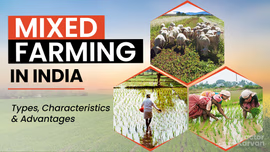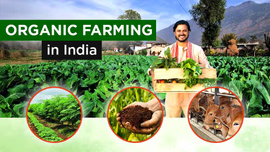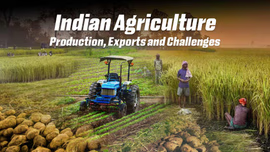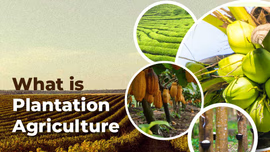Dryland Farming in India: Maximizing Moisture in Drylands

Dryland farming is prevalent in areas where there is limited, uncertain and ill-distributed rainfall. It is adopted to cultivate drought-tolerant crops. With advancements in technology, there is a need for improvements in dryland farming to achieve higher productivity and address key challenges. Today’s blog explores all about dryland farming along with its characteristics, techniques & government initiatives.
Table of Contents
- What is the Dryland Farming?
- What is the Importance of Dryland Farming in India?
- Dryland Farming Techniques
- What is Difference between Dry Farming and Dryland Farming?
- What are the Problems/Challenges of Dryland Farming?
- What are the Government Initiatives for Dryland Farming?
- Way Forward
What is the Dryland Farming?
Dryland agriculture means cultivating crops under natural rainfall conditions without or very scanty irrigation source. The key characteristics of drylands include limited rainfall and water, lack of moisture availability, and single crop/intercropping system. Drylands are sometimes interchangeably referred to as rainfed regions, as both depend on rainfall. Although they have certain similar attributes, they are vastly different. Dryland farming is usually practised in arid and semi-arid regions to cultivate drought-resistant crops. Several factors, such as loss of natural vegetation, soil texture and structure, and chemical degradation, cause land degradation. Drylands experience extreme climatic hazards, such as droughts, that lead to less water availability and low productivity.
What is the Importance of Dryland Farming in India?
Dryland farming is an important aspect in Indian agriculture as it occupies a majority of land in India. Many Districts of Rajasthan, Gujarat, Maharashtra, and Madhya Pradesh are the areas where there is a very low rainfall. Thus, dryland farming is not just a sustainable method but it provides food security to the nation. It helps in food production by growing drought-resistant crops, such as millets, groundnuts, and pulses. It also helps in economic survival and ecological persistence.
In India, 130 districts are identified as dry farming regions. Uttar Pradesh, Madhya Pradesh, Tamil Nadu, and Chhattisgarh cover 91 districts, while the remaining districts are located in the Western Ghats (rain shadow region), Central Rajasthan and Saurashtra region of Gujarat. Also, major dryland crops include pulses, rapeseed, ragi, bajra and jowar.
Dryland Farming Techniques
There are several dry farming techniques that are used to reduce water runoff, evaporation and transpiration losses. Some of the most common techniques are as follows:
- Bunding: Bunding is one of the most important steps in dryland farming. It involves surveying the land and determining level contours. Bunding results in improved water infiltration and soil moisture due to slower water runoff.
- Tillage: It involves preparing the soil for the cultivation of crops. Tillage opens up the surface soil to facilitate water entry through it. Conservation tillage minimises soil disturbance and helps to conserve water and prevent soil erosion.
- Mulching: This technique reduces evaporation losses by covering the surface with organic materials like grass and straw. Mulches conserve more moisture when there is frequent rainfall. Mulching also has additional benefits like weed control, reduced soil salinity and soil conservation.
- Fallowing: In this practice, nothing is sown on the land for at least one vegetative cycle. During this period, the moisture is stored, which can help grow crops post-rainy season. Also, it allows the land to recover and store organic matter.
- Rainwater Harvesting: Rainwater harvesting is an important practice in dryland farming. In arid and semi-arid regions, rainwater is collected in ponds, tanks, or trenches for use during dry spells.
What is Difference between Dry Farming and Dryland Farming?
|
Dry Farming |
Dryland Farming |
|
Dry farming is an agricultural practice where crops are grown with barely any water in dry climates. |
Dryland farming is usually practiced in semiarid areas where crops are grown with a limited water source. |
|
Dry farming done in regions that receive less than 750 mm of rainfall annually. |
Dryland farming is specific to regions with more than 750 mm of rainfall. |
|
Crops include millet, pulses, oilseeds, etc. |
The major dryland crops are wheat, barley, cotton, legumes, etc. |
What are the Problems/Challenges of Dryland Farming?
Dryland crops are known for uncertain and low yields. It is mainly because of the following reasons:
- Low Moisture Retention: The soil is less fertile due to soil and moisture problems. This is due to issues like soil degradation, soil erosion, and salinization.
- Uneven Rainfall Distribution: Due to low rainfall, there is uncertain crop yield. During the crop period, there is uneven rainfall distribution. So, the crops get more rainwater when there is no need.
- Prolonged Dry Spells: There are prolonged dry spells, which reduce crop growth. Also, it results in low moisture retention capacity in coarse-textured and red soils.
- Low Soil Fertility: Chemical fertilizers cannot be used extensively to increase soil fertility as soil moisture is inadequate.
What are the Government Initiatives for Dryland Farming?
Some of the major steps taken by the government to improve dryland farming include:
- In 1983, ICAR started the All India Coordinated Research Project on Agrometeorology (AICRPAM) to research key themes like the impact of weather on diseases and pests, crop-weather modelling, crop-weather relationships, agromet advisory services and agroclimatic characterization.
- National Mission for Sustainable Agriculture has implemented the Centrally Sponsored Scheme of Rainfed Area Development (RAD) Programme.
- CRIDA has established modern facilities to study climate change and improve dryland agriculture. It has formed a dryland research network nationwide with 31 AICRPDA centres in 17 states.
- 24 districts drought proofing plans and 650 District Agricultural Contingency Plans (DACPs) were prepared by CRIDA with the association of the National Agricultural Research Extension & Education System (NAREES).
Way Forward
Small and marginal farmers form the major population involved in dryland farming. Thus, there is a need for improvements in this farming method to improve their economic status and alleviate poverty. Due to the rapidly increasing population and fluctuation in the production of food grains, dryland farming has become more critical.
Today, dry farming techniques have evolved to increase the water use efficiency. The government supports several programmes to aid investment in water management, including watershed and rainwater harvesting programmes. India is a huge importer of vegetable oils such as Safflower and sunflower. Oilseed production in the dry regions can be improved using technologies that save key foreign exchange reserves. Dryland areas majorly grow crops like ragi, bajra and jowar. If their productivity increases, people in these areas can get nutrient-dense cereals.
There is a huge scope for fodder production in marginal lands of the semi-arid regions. Feeding the cattle population is an important aspect of farming in drylands. Also, the production of food grains can be increased in dryland areas. It would improve the country's agriculture-dependent economy and address the challenges of malnutrition and hunger.
Frequently Asked Questions On Dryland Farming in India
1. What is dryland farming?
Dryland farming is a farming method in arid and semi-arid regions that grows drought-resistant crops without irrigation.
2. What is the difference between dryland and wetland farming?
Dryland farming is done in areas that lack soil moisture due to low rainfall. On the other hand, wetland farming is practised where the soil has excess moisture due to heavy rainfall.
3. What are dryland farming techniques?
Dryland farming methods include bunding, tillage, mulching, fallowing and rainwater harvesting.
4. What crops are good for dryland farming?
Dryland farming is suitable for crops like pulses, rapeseed, ragi, jowar and bajra.


Related Blogs












